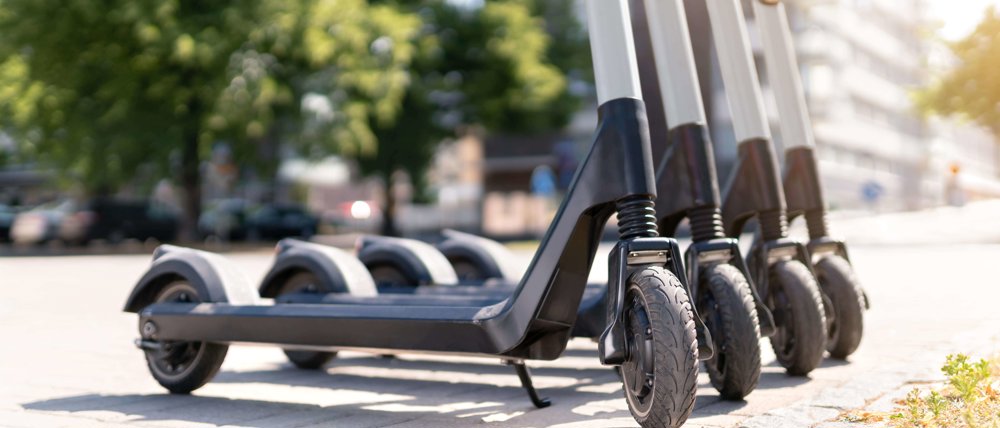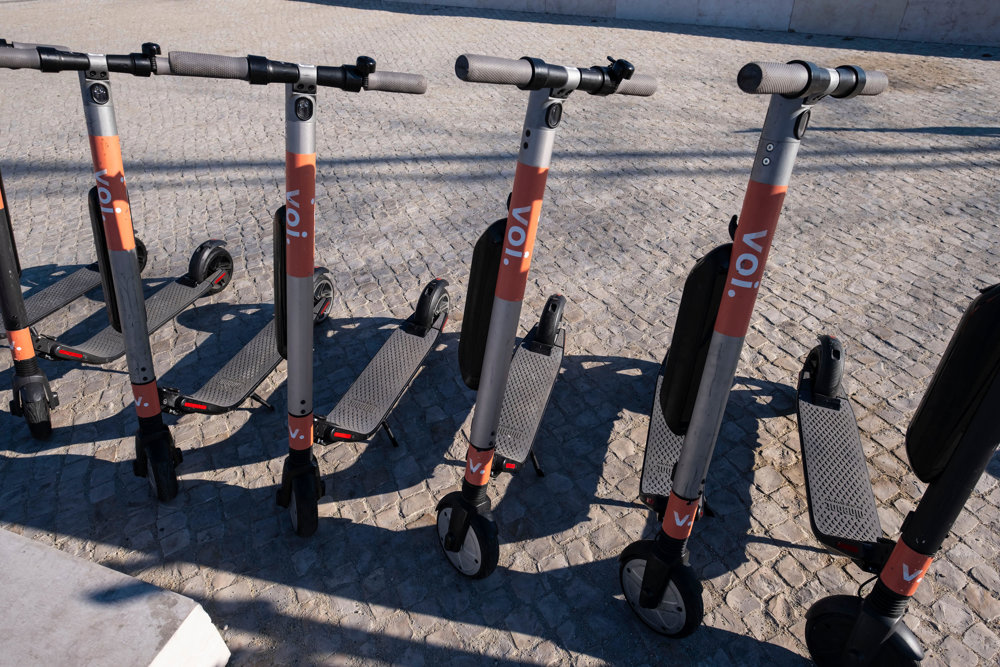Up until recently, e-scooters were illegal in the UK on public land. However, to ease pressure on public transport during the coronavirus pandemic, e-scooter trials have been fast tracked to begin a year earlier than planned and thus are legal as of July 4th.
This change comes as part of a wider attitude that as lockdown is lifted and traffic returns to streets, a greater variety of transport options must be considered both from an environmental and social perspective. However, not everyone will be able to utilise this micro-mobility transport option just yet, the new legal framework only covers rental scooters that are part of the trials. This report will outline the current legalities of using an e-scooter in the UK, the possible benefits and concerns surrounding their permanent adoption, and the practicalities that will come with their incorporation into the urban environment.
Legal Context for the Use of Electric Scooters
Powered transporters, a term that covers a variety of personal transport devices which are mechanically propelled, have often been termed a grey area in transport legislation. The term includes e-scooters, Segways, hoverboards, go-peds, powered unicycles and u-wheels but does not include electrically-assisted pedal cycles (EAPCs) which have their own regulatory framework[1]. E-scooters fall under the legal definition of ‘motor vehicle’ meaning it is illegal to use them in space set aside for pedestrians, cyclists, and horse riders, i.e. the footway (Note - pavement in highway terms refers to the whole carriageway including the footway) and cycle lanes. However, if used on the road, they must meet several ‘road legal’ requirements including insurance, vehicle tax, licensing and registration, all of which would be very difficult to comply with. On private land, there are currently no restrictions but the permission of the owner or occupier of the land is required. Therefore, while it is easy to go online and buy an e-scooter, it is currently an offence to use it in most locations.
To legally use an e-scooter in the UK, you must use one that is part of the new trials.
E-Scooter Trials
The UK electric scooter trials will initially involve 100 scooters and are due to last 12 months[2]. The rules surrounding these trials are for rental scooters only, and private e-scooters will remain illegal, however these trials will likely set the precedent for what we could expect if e-scooters are permanently legalised. The rules that have been set for the trials include:
- Maximum speed limit of 15.5mph
- Users must have the Category Q entitlement on their full or provisional UK driving licence
- Users must be 16 or over
- Motor insurance must be provided by the e-scooter rental operator
- Only one person can use the scooter at a time
[1] Department for Transport, ‘Powered Transporters’, Gov.UK [Website], https://www.gov.uk/government/publications/powered-transporters/information-sheet-guidance-on-powered-transporters, (accessed 20th July 2020)
[2] S. Osborne, ‘Government issues e-scooter rules as trials begin in UK’, Independent [Website], https://www.independent.co.uk/news/uk/home-news/escooter-rules-uk-government-trial-tees-valley-darlington-hartlepool-middlesborough-redcar-cleveland-a9616166.html, (accessed 20th July 2020)
These e-scooters will be permitted to be used on the road and in cycle lanes, but not on footways. As e-scooters will not need to be registered or pay vehicle excise duty, it is apparent that they will be under similar regulations to EAPCs.
The trials have been designed to understand whether e-scooters can offer “clean and cost-effective travel that may also help ease the burden on the transport network, provide another green alternative to get around and allow for social distancing"[3]. They currently only cover rental schemes so as to mitigate against the risk of a flood of poor-quality scooters on the streets and enable the monitoring of e-scooter use and rider behaviour.
The Benefits of E-Scooter Use
There is a significant positive backing for the wider implementation of e-scooters across the UK. Micro-mobility options have the potential to reduce congestion which in turn will improve commuting experiences and thus quality of life. They have been termed an innovative transportation strategy as they allow users to have short-term access to a transportation mode on an as-needed basis.
The benefits of e-scooter use are wide-ranging. The UK department for transport (DfT) acknowledged in their Future of Transport Review[4] that new mobility services must lead the transition to zero emissions and that mobility innovation must help reduce congestion through more efficient use of limited road space. E-scooters also have the potential to be most effective at reducing congestion and contributing to the move towards zero emissions if they are used as an alternative for trips that would otherwise have been taken in a car. It is essential that the scooters replace trips that otherwise would have been taken in a vehicle, rather than replacing trips which may have been made using active modes, for there to be a positive environmental impact.
Another positive opportunity is for ‘last mile’ deliveries and ‘last mile to work’. The first of these trends involves getting parcels from hubs to their final destinations, which, if delivered by e-scooter, would have a huge impact on transport emissions. The second involves the encouragement to walk the last mile of your commute. While an e-scooter is not an active mode of transport, it is a greener solution and may help cultivate behavioural trends that allow people to see the benefits of not driving their entire commute. The e-scooter and its use for the ‘last mile’ could therefore lead to reduced congestion and more efficient use of road space.
The DfT also note that e-scooters have the potential to be more inclusive, providing new transport choices for some disabled or older people that otherwise may not be able to walk medium or long distances and would choose to make the journey in a car. As they can be rented on an ‘as-and-when’ basis means they are a hugely accessible transport option to people of all backgrounds.
Perhaps the most attractive element of e-scooters is how they facilitate hybrid transport. They can be ridden in bicycle lanes, pushed alongside to walk on pavements and folded to carry on foot to take public transport. They allow the user to adjust to the situation, and thus have the potential to decrease journey times significantly if used in this manner.
[3] BBC, ‘Rental e-scooters to be made legal on roads in Great Britain from Saturday’, BBC News [Website], https://www.bbc.co.uk/news/uk-53219331#:~:text=Rental%20e%2Dscooters%20will%20become,scooter%2Dfor%2Dhire%20firms (accessed 20th July 2020)
[4] Department for Transport, ‘Future of Transport Regulatory Review, Call for Evidence’, Gov.UK, 2020, https://assets.publishing.service.gov.uk/government/uploads/system/uploads/attachment_data/file/886686/future-of-transport-regulatory-review-call-for-evidence.pdf, (accessed 20th July 2020)
Concerns Around E-Scooters
Despite the new opportunities for inclusivity and less pollution e-scooters may offer, there are considerable concerns regarding the safety, use of public space and environmental damage that may come with them[5].
Safety must remain of utmost importance, especially as the addition of e-scooters to the streetscape poses a threat to vulnerable road users including pedestrians and cyclists. We don’t yet have robust accident data available, however patterns from American cities indicate numerous hospital admissions and a number of deaths associated with e-scooters[6]. Therefore, if they do become a permanent addition to our society, they must be introduced into the network in the safest way possible for all road users.
|
Case Studies o In Berlin, Germany, electric scooters must be used on the road or cycle lanes (where available) but not on the pavement. Users must have insurance and the vehicle must be registered, but a driving licence is not required. o In Barcelona, Spain, e-scooters can use cycle lanes at speeds up to 6mph and on roads up to 18.6mph but cannot be used on pavements. o In Singapore, they must be registered and can only be used on cycle paths, not on the road or pedestrian-only paths. These case studies alongside the current trials in the UK indicate that if e-scooters are rolled out country wide on a permanent basis, they will most likely be constrained to cycle lanes and will have to follow any guidelines set out for cyclists.
|
What this Means in Practice
The legalisation of e-scooters may require the reshaping of public space. If the use of light electric vehicles will be promoted, then cycle-lanes and pedestrian space will need to be adapted to accommodate them. Cycle lanes may be transitioned to ‘personal vehicle lanes’, however there is a worry that at peak times, different cycle lane users who have different speeds and space needs may cause congestion[7]. This has been seen in the Netherlands where micro-mobility vehicles are causing traffic congestions and accidents on saturated cycle lanes. It has therefore been noted that the solution for space in dense urban ecologies is to re-allocate space currently given to cars to lighter forms of mobility. In response to the coronavirus pandemic, councils have already begun relocating road space for pedestrians and cyclists to allow for social distancing. This will be important if e-scooters are to be incorporated into the existing built environment as it will stop road users competing for space.
As well as ensuring their safety in the urban environment, it is important that their use, parking, storage and operations are properly managed. A review of micro-mobility by Tice[8] recommends that walking audits should be used extensively to qualitatively review urban environments for walkability. This will ensure that the introduction of e-scooters does not lead to an eradication of the pedestrian experience. Audits should be used to identify and pre-emptively mitigate for conflicts between vehicle types and designate appropriate facilities and parking.
[5] S. Tuncer and B. Brown, ‘E-scooters on the Ground: Lessons for Redesigning Urban Micro-Mobility’ In Proceedings of the 2020 CHI Conference on Human Factors in Computing Systems, 2020, pp. 1-14
[6] See reference 4
[7] See reference 5
[8] P.C. Tice, ‘Micromobility and the Built Environment’, In Proceedings of the Human Factors and Ergonomics Society Annual Meeting, Sage CA: Los Angeles, CA: SAGE Publications, 2019, Vol. 63, No. 1, pp. 929-932
Lessons can be learnt from studying the behaviour of e-bike users and e-scooter users in other countries, to facilitate planning for e-scooter users in the UK. A 2020 study by Reck et al.,[9] in Zurich showed that docked e-bikes were preferred for commuting while e-scooter use peaked during off-peak hours. Furthermore, the probability of choosing an e-bike tends to increase with length of journey, but probability of choosing an e-scooter decreases. These findings will be important when considering whether to put e-bike or e-scooter docks into developments going forward.
Conclusions
The fast-tracked legalisation of rented e-scooters in the UK may provide a viable alternative to public transport at a time when social distancing and solo travel is favoured. The trials allow e-scooters to be used in cycle lanes and as public space is re-allocated to pedestrians and cyclists in response to Covid-19, there is now greater room for micro-mobility options to be explored.
The benefits are promising, not just environmentally but also from a social perspective. The flexible nature of e-scooters may reduce commuting times and thus increase quality of life, alongside providing an affordable transport option for people from all backgrounds. However, it is important that the valid concerns regarding e-scooters are not brushed over in the rush to provide socially distant friendly transport solutions. Safety must be of utmost priority and the needs of all road users must be considered for their use to be successfully implemented on a permanent basis. Furthermore, it is important that the e-scooters replace trips that would have been made by a motor vehicle, not by active modes, for there to be genuinely positive environmental impacts.
Over the next 12-months, e-scooter user behaviour will need to be monitored closely to see whether they can provide the cost-effective, green, socially distant friendly option we are hoping for.
[9] D. J. Reck et al., ‘Shared micromobility in Zurich, Switzerland: Analysing usage, competition and mode choice’ In 20th Swiss Transport Research Conference (STRC 2020), IVT, ETH Zurich, 2020, p. 66








